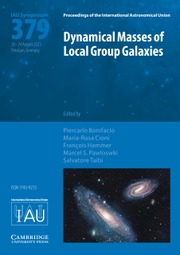No CrossRef data available.
Article contents
Redshift-Space Distortions and f(z) from Group-Galaxy Correlations
Published online by Cambridge University Press: 12 October 2016
Abstract
Core share and HTML view are not available for this content. However, as you have access to this content, a full PDF is available via the ‘Save PDF’ action button.
We investigate the accuracy achievable on measurements of the the growth rate of structure f(z) using redshift-space distortions (RSD), when (a) these are measured on the group-galaxy cross correlation function; (b) the latter is expanded over a modified version of the conventional spherical armonics, “truncated multipole moments”. Simulation results give first indications that this combination can push systematic errors on f(z) below 3%, using scales r ⩾ 10h −1 Mpc.
Information
- Type
- Contributed Papers
- Information
- Proceedings of the International Astronomical Union , Volume 11 , Symposium S308: The Zeldovich Universe: Genesis and Growth of the Cosmic Web , June 2014 , pp. 342 - 343
- Copyright
- Copyright © International Astronomical Union 2016

